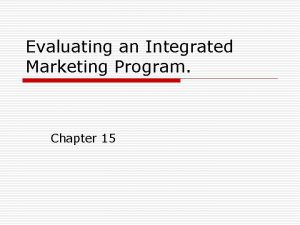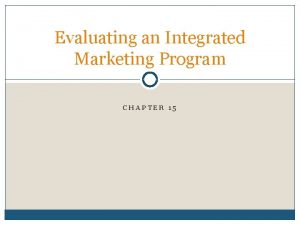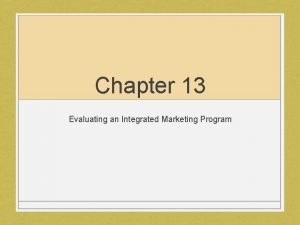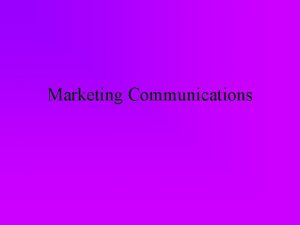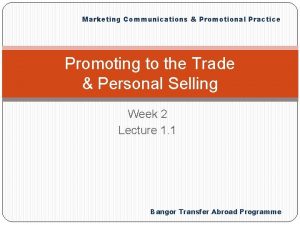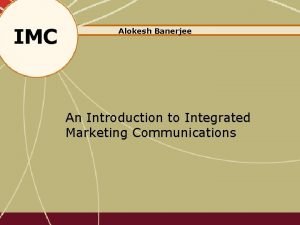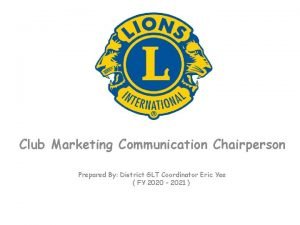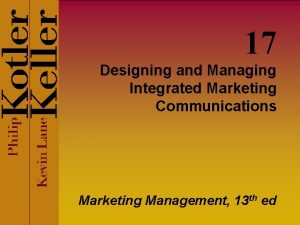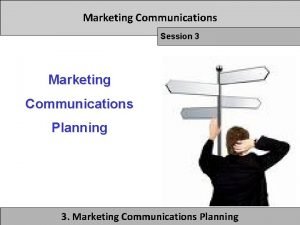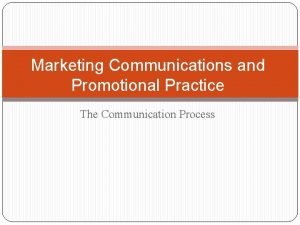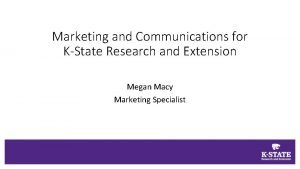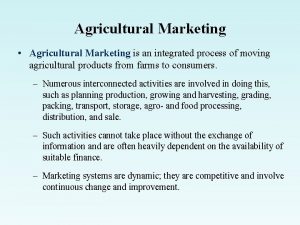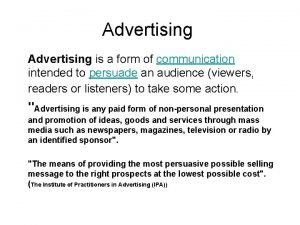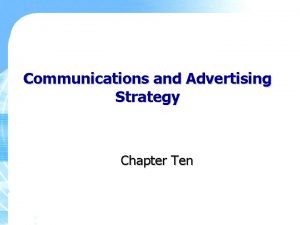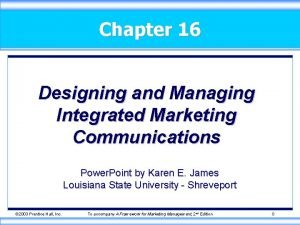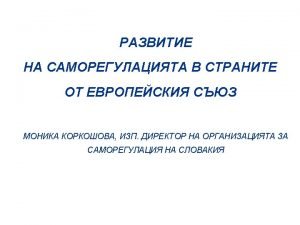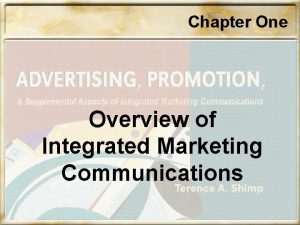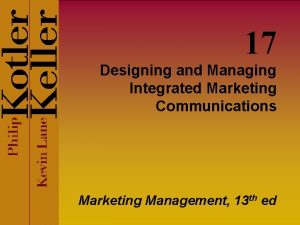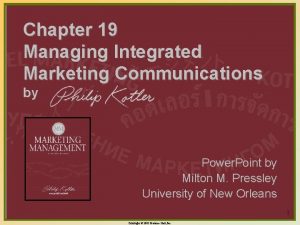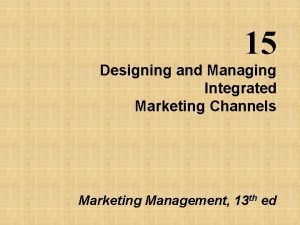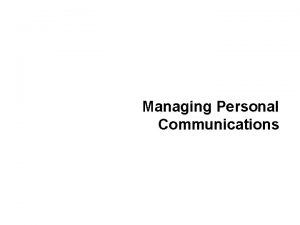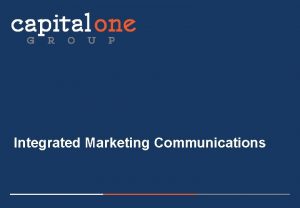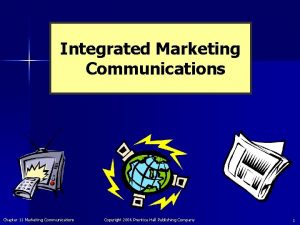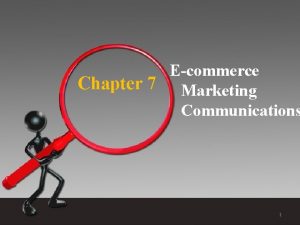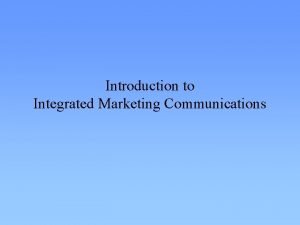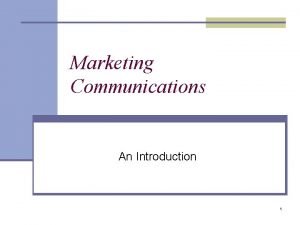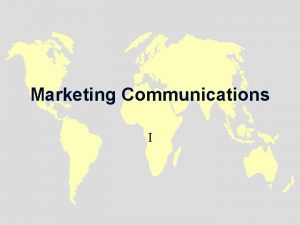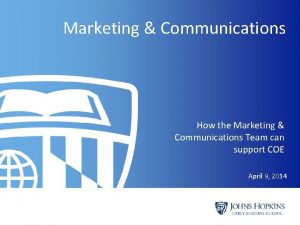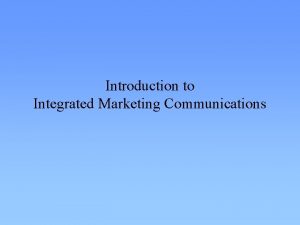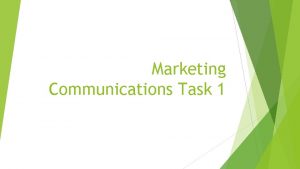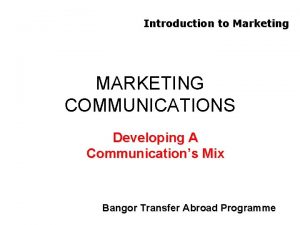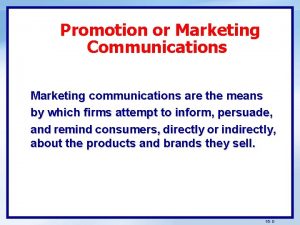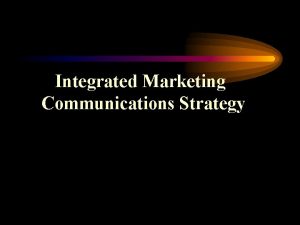Chapter 12 Evaluating Marketing Communications Programs 1 2005
























- Slides: 24

Chapter 12 Evaluating Marketing Communications Programs 1 © 2005 Pearson Education Canada Inc.

Role of Marketing Research links consumers and organizations through information. As a marketing tool it is used to help reduce or eliminate the uncertainty and risk associated with business decisions. Research can: 1. Define marketing problems and opportunities 2. Refine and evaluate marketing actions 3. Monitor marketing performance 4. Improve understanding of the marketing process. 2 © 2005 Pearson Education Canada Inc.

Research and Communications In a marketing communications context, research is primarily used to: 1. Track brand awareness 2. Pre-test and Post-test advertising strategies 3. Measure changes in behaviour. 3 © 2005 Pearson Education Canada Inc.

Steps in Primary Research Problem Definition Objectives and Hypotheses Sample Design Data Collection 4 © 2005 Pearson Education Canada Inc.

Objectives and Hypotheses 5 Objectives Statements relating to what the research will accomplish. Hypotheses Statements of predicted outcomes that the data will confirm or deny. © 2005 Pearson Education Canada Inc.

Sample Design A representative sample is necessary in order to produce valid and reliable data. There are four steps in designing a good sample. 1. Define the population 2. Identify the sampling frame 3. Determine the type of sample 4. Determine the sample size 6 © 2005 Pearson Education Canada Inc.

Data Collection Methods Survey Observing by personal or electronic means. Experiment 7 Structured surveys and fixedresponse questions. Observation Collecting data in a simulated environment. © 2005 Pearson Education Canada Inc.

Qualitative and Quantitative Data Research often involves the collection of both types of data. Qualitative Collected from large samples using structured methods. 8 Collected from small samples in a controlled environment (focus groups). Quantitative © 2005 Pearson Education Canada Inc.

Survey Methodology Interview Telephone Mail The decision on which method to use is based on: 1. Nature of information sought 2. Cost and time constraints 3. Location and habits of respondent. Online 9 © 2005 Pearson Education Canada Inc.

Data Processing Data Transfer Questionnaires are edited for consistency and completeness • Tabulation • Frequency Distribution • Cross-tabulation 10 Data Processing © 2005 Pearson Education Canada Inc.

Data Analysis and Interpretation Data Analysis Relating accumulated data to the problem, objectives and hypotheses. 11 Evaluating responses on a question-by-question basis. Data Interpretation © 2005 Pearson Education Canada Inc.

Recommendations and Implementation Once the data has been analyzed it is directly linked to some form of action. 1. The research company recommends certain courses of action. 2. The data is presented by the research company verbally and in report form. 12 © 2005 Pearson Education Canada Inc.

Client Evaluation of Creative An initial assessment by a client (of an agency creative recommendation) is to ensure that the message is “on strategy. ” The following questions are answered: 1. Does the ad communicate the creative objectives? 2. Is the ad in accordance with positioning strategy? 3. Does the ad mislead or misrepresent the intent of the message? 4. Is the ad memorable? 5. Is their sufficient brand recognition? 13 © 2005 Pearson Education Canada Inc.

Message Research Techniques The evaluation of messages can occur at any stage of the creative development process. 14 Pre-testing Testing before final production or media placement. Post-testing Testing during or after an ad or campaign has run. © 2005 Pearson Education Canada Inc.

Testing Message Impact Recognition Test Recall Test 15 Respondents are tested for awareness of brand advertised and key message points. Respondents are asked to name or recall ads, specific elements of the ads, characters, and slogans. © 2005 Pearson Education Canada Inc.

Testing Message Impact The Starch readership test is a post-test recognition technique used in print media. Noted - % of readers who remember seeing an ad Associated - % of readers who saw an ad an can identify the brand or advertiser. Read Most - % of readers who read more than half of an ad. 16 © 2005 Pearson Education Canada Inc.

Testing Message Impact DAR tests are common in post-test recognition and recall situations. Measures for intrusiveness and impact: • % of respondents recalling the advertised brand. • % of respondents who can describe key elements of the message. 17 © 2005 Pearson Education Canada Inc.

Pre-Test Commercial Testing An opinion-measure test exposes an audience to TV commercials in a theatre environment. Respondents are asked a series of questions about a test commercial. The test measures: • Brand name recall • Recall of main ideas (key selling points) • Likelihood of purchase (ability to motivate) 18 © 2005 Pearson Education Canada Inc.

Physiological Testing Some test methods measure involuntary responses to an advertisement. • Eye-Movement Camera Test • Pupilometer Test • Voice-Pitch Analysis Test 19 © 2005 Pearson Education Canada Inc.

Evaluating Sales Promotions are intended to increase sales in the shortterm. Beyond looking at sales, other measures include: 1. Response rates to coupon offers 2. Numbers of entries to contests and other mailin offers 3. Effective use of point-of-purchase material 4. Financial payout 20 © 2005 Pearson Education Canada Inc.

Evaluating Direct Response Online 21 Inquiries from toll-free numbers and response cards • Ad clicks • Impressions • Site “stickiness” • Online surveys © 2005 Pearson Education Canada Inc.

Evaluating Public Relations With public relations you get what the media gives; the media controls the message. 1. Press clippings as a percentage of press releases issued. 2. Impressions generated based on circulation and readership; numbers of listeners and viewers. 3. Advertising equivalency. 22 © 2005 Pearson Education Canada Inc.

Evaluating Event Marketing Event marketing and sponsorships are valued by marketers but are very difficult to measure for effectiveness. Some measures include: 1. Ability to effectively reach the target market 2. Awareness created and association with the event 3. Image enhancement due to participation 4. New business and sales increases 23 © 2005 Pearson Education Canada Inc.

Measuring the IMC Effort It is the collection of IMC that stimulates responses, therefore, the total effort is measured based on: 1. Sales 2. Market Share 3. Consumer Perceptions 4. Customer Satisfaction If the business is moving positively, marketing communications is working! 24 © 2005 Pearson Education Canada Inc.
 Disadvantages of waterfall model in software engineering
Disadvantages of waterfall model in software engineering Evaluating an integrated marketing program
Evaluating an integrated marketing program Evaluating an integrated marketing program
Evaluating an integrated marketing program Evaluating an integrated marketing program
Evaluating an integrated marketing program Evaluating an integrated marketing program
Evaluating an integrated marketing program What is encoding in marketing communication
What is encoding in marketing communication Push pull profile strategies marketing communications
Push pull profile strategies marketing communications Alokesh banerjee
Alokesh banerjee Global marketing and communications
Global marketing and communications Club marketing communications chairperson
Club marketing communications chairperson Amplified expressiveness
Amplified expressiveness Push and pull strategy
Push and pull strategy Dagmar model
Dagmar model K state communications and marketing
K state communications and marketing Agriculture marketing process
Agriculture marketing process Push pull profile strategies marketing communications
Push pull profile strategies marketing communications Coca cola imc
Coca cola imc 6m model of marketing communications
6m model of marketing communications Designing and managing integrated marketing communications
Designing and managing integrated marketing communications Wythm
Wythm Advertising and marketing communications
Advertising and marketing communications Overview of integrated marketing communications
Overview of integrated marketing communications Designing and managing integrated marketing channels
Designing and managing integrated marketing channels Managing integrated marketing communication process
Managing integrated marketing communication process Designing and managing integrated marketing channels
Designing and managing integrated marketing channels


